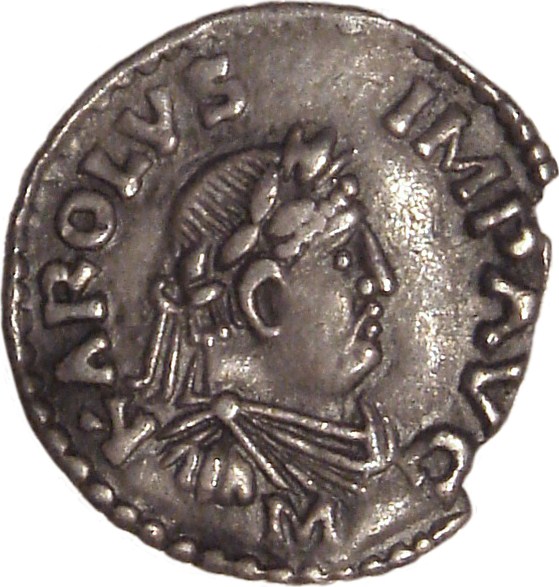
Charlemagne
Charlemagne[b] (/ˈʃɑːrləmeɪn, ˌʃɑːrləˈmeɪn/ SHAR-lə-mayn, -MAYN; 2 April 748[a] – 28 January 814) was King of the Franks from 768, King of the Lombards from 774, and Emperor of what is now known as the Carolingian Empire from 800, holding these titles until his death in 814. He united most of Western and Central Europe and was the first recognised emperor to rule in the west after the fall of the Western Roman Empire, approximately three centuries earlier. Charlemagne's reign was marked by political and social changes that had lasting impact on Europe throughout the Middle Ages.
For other uses, see Charlemagne (disambiguation).Charlemagne
9 October 768 – 28 January 814
9 October 768
Noyon
June 774 – 28 January 814
25 December 800 – 28 January 814
25 December 800
Old St. Peter's Basilica, Rome
2 April 748[a]
- Hildegard
(m. 771; d. 783)
Chalcedonian Christianity (Pre-Schism Catholic)
A member of the Frankish Carolingian dynasty, Charlemagne was the eldest son of Pepin the Short and Bertrada of Laon. With his brother, Carloman I, he became king of the Franks in 768 following Pepin's death and became the sole ruler three years later. Charlemagne continued his father's policy of protecting the papacy and became its chief defender, removing the Lombards from power in northern Italy in 774. His reign saw a period of expansion that led to the conquests of Bavaria, Saxony and northern Spain, as well as other campaigns that led Charlemagne to extend his rule over a large part of Europe. Charlemagne spread Christianity to his new conquests (often by force), as seen at the Massacre of Verden against the Saxons. He also sent envoys and initiated diplomatic contact with the Abbasid caliph Harun al-Rashid during the 790s, due to their mutual interest in Spanish affairs.
In 800, Charlemagne was crowned emperor in Rome by Pope Leo III. Although historians debate the coronation's significance, the title represented the height of his prestige and authority. Charlemagne's position as the first emperor in the West in over 300 years brought him into conflict with the Eastern Roman Empire in Constantinople. Through his assumption of the imperial title, he is considered the forerunner to the line of Holy Roman Emperors, which persisted into the nineteenth century. As king and emperor, Charlemagne engaged in a number of reforms in administration, law, education, military organization, and religion, which shaped Europe for centuries. The stability of his reign began a period of cultural activity known as the Carolingian Renaissance.
Charlemagne died in 814 and was laid to rest at Aachen Cathedral in Aachen, his imperial capital city. He was succeeded by his only surviving son, Louis the Pious. After Louis, the Frankish kingdom was divided and eventually coalesced into West and East Francia, which later became France and the Holy Roman Empire, respectively. Charlemagne's profound impact on the Middle Ages and influence on the territory he ruled has led him to be called the "Father of Europe" by many historians. He is seen as a founding figure by multiple European states and a number of historical royal houses of Europe trace their lineage back to him. Charlemagne has been the subject of artworks, monuments and literature during and after the medieval period and is venerated by the Catholic Church.
Name[edit]
Several languages were spoken in Charlemagne's world, and he was known to contemporaries as Karlus in the Old High German he spoke; as Karlo to Romance speakers; and as Carolus (or Karolus)[2] in Latin, the formal language of writing and diplomacy.[3] Charles is the modern English form of these names. The name Charlemagne, as the emperor is normally known in English, comes from the French Charles-le-magne ("Charles the Great").[1] In modern German, he is known as Karl der Große.[4] The Latin epithet magnus ("great") may have been associated with him during his lifetime, but this is not certain. The contemporary Royal Frankish Annals routinely call him Carolus magnus rex ("Charles the great king").[5] That epithet is attested in the works of the Poeta Saxo around 900, and it had become commonly applied to him by 1000.[6]
Charlemagne was named after his grandfather, Charles Martel.[7] That name, and its derivatives, are unattested before their use by Charles Martel and Charlemagne.[8] Karolus was adapted by Slavic languages as their word for "king" (Russian: korol', Polish: król and Slovak: král) through Charlemagne's influence or that of his great-grandson, Charles the Fat.[9]
Reign as emperor[edit]
Coronation[edit]
After Leo III became pope in 795, he faced political opposition. His enemies accused him of a number of crimes and physically attacked him in April 799, attempting to remove his eyes and tongue.[181] Leo escaped and fled north to seek Charlemagne's help.[182] Charlemagne continued his campaign against the Saxons before breaking off to meet Leo at Paderborn in September.[183][184] Hearing evidence from the pope and his enemies, he sent Leo back to Rome with royal legates who were instructed to reinstate the pope and conduct a further investigation.[185] In August of the following year, Charlemagne made plans to go to Rome after an extensive tour of his lands in Neustria.[185][186] Charlemagne met Leo in November near Mentana at the twelfth milestone outside Rome, the traditional location where Roman emperors began their formal entry into the city.[186] Charlemagne presided over an assembly to hear the charges, but believed that no one could sit in judgement of the pope. Leo swore an oath on 23 December, declaring his innocence of all charges.[187] At mass in St. Peter's Basilica on Christmas Day 800, Leo proclaimed Charlemagne emperor and crowned him. Charlemagne was the first reigning emperor in the west since the deposition of Romulus Augustulus in 476.[188] His son, Charles the Younger, was anointed king by Leo at the same time.[189]